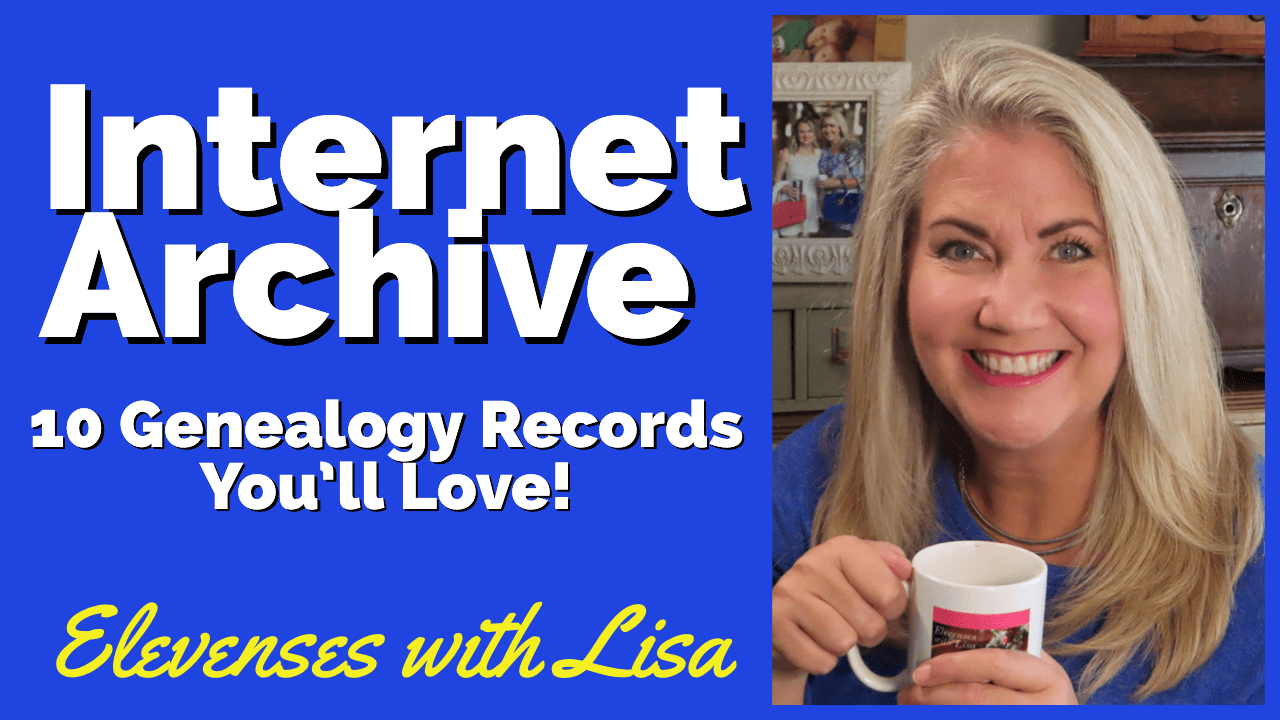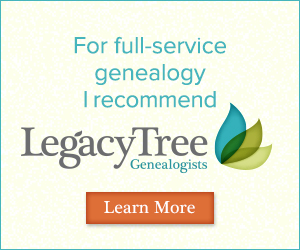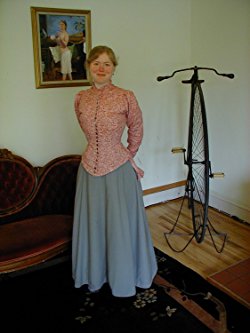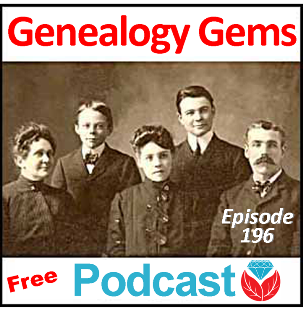Why You Should Have a Free FamilySearch Account–And Use It!
A free FamilySearch account gives you access to more historical records and customized site features than you’ll see if you don’t log in at this free genealogy website. Here’s why you should get a free FamilySearch account and log in EVERY time you visit the...Ultimate Guide to 1890 Census and Substitute Records
Video & Show Notes
Click the video player to watch episode 54 of Elevenses with Lisa about the 1890 census and substitute records. Below you’ll find the detailed show notes with all the website links I mention. Premium Members will find the downloadable ad-free PDF cheat sheet of these show notes at the bottom of this page in the Resources section, along with my BONUS 1890 Census Gap Worksheet.
What Happened to the 1890 Census
The census shows us our ancestors grouped in families, making it a valuable resource for genealogy. Soon the 1950 census will be available, but for now the most current census publicly available in 1940. In it we may find, depending on our age, ourselves, our parents, our grandparents, and our great parents. In many cases it’s quick and rewarding to make your way back in time to the 1890 census which was taken starting June 1, 1890. And that’s where the trail hits a bump. In January 1921 a large fire broke out in the Commerce Building in Washington DC where the 1890 census records were stored, and most were destroyed as a result. Only 6,160 individual names remain in the remnants. (Learn more about the destruction of the 1890 census at the National Archives.)
Prior to the 1890 U.S. Federal Census, the last census taken was in 1880. With about 99% of the 1890 being destroyed as the result of the fire, this leaves a 20 year gap in the census (1880 – 1900.)
Much can happen in a span of twenty years. For example, your ancestors could have been born and reached adulthood. Filling in their timeline for this period requires a bit more effort, but the results are worth it.
In this video and article we’ll cover:
- How to find the remaining fragments of the 1890 population enumeration
- What you can learn from the 1890 census records
- Lesser known 1890 census schedules that can still be found.
- The best 1890 substitute records and how to find them.
Surviving 1890 Federal Census Population Schedules
A very small portion of the 1890 census has survived, but it’s more than just the population schedule. Here are the six types of records still available.
1. 1890 Federal Population Schedule Fragments
How to find the records:
- Fragments of the 1890 Federal Census covering just 6160 individuals managed to survive and are available online at Ancestry.
- Browse the 1890 Census fragments at FamilySearch.
- Searchable index for 1890 census at FamilySearch.
List of the locations covered by the surviving 1890 federal census:
Alabama: Perryville Beat No.11 (Perry County) and Severe Beat No.8 (Perry County)
District of Columbia: Q Street, 13th St., 14th St., R Street, Q Street, Corcoran St., 15th St., S Street, R Street, and Riggs Street, Johnson Avenue, and S Street
Georgia: Columbus (Muscogee County)
Illinois: Mound Township (McDonough County)
Minnesota: Rockford (Wright County)
New Jersey: Jersey City (Hudson County)
New York: Brookhaven Township (Suffolk County) and Eastchester (Westchester County)
North Carolina: South Point and River Bend Townships (Gaston County), Township No. 2 (Cleveland County)
Ohio: Cincinnati (Hamilton County) and Wayne Township (Clinton County)
South Dakota: Jefferson Township (Union County)
Texas: J.P. No. 6, Mountain Peak, Ovilla Precinct (Ellis County), Precinct No. 5 (Hood County), No. 6 and J.P. No. 7 (Rusk County), Trinity Town and Precinct No. 2 (Trinity County), and Kaufman (Kaufman County)
Questions Asked in the 1890 U.S. Federal Census
The following questions were asked by the census taker:
- Name
- Age
- Sex
- Address
- Number of families in the house
- Number of persons in the house
- Number of persons in the family
- Relationship to head of family
- Race: white, black, mulatto, quadroon, octoroon, Chinese, Japanese, or Indian
- Marital status
- Whether married during the year
- Total children born to mother
- Number of children living
- Birthplace
- Birthplace of parents
- If foreign born, how many years in the United States
- Naturalized or in the process of naturalization
- Profession, trade, or occupation
- Months unemployed during census year
- Able to read and write
- Speak English; if not, language or dialect spoken
- Suffering from acute or chronic disease (if so, name of disease and length of time afflicted)
- Defective in mind, sight, hearing, or speech
- Crippled, maimed, or deformed (with name of defect)
- Prisoner, convict, homeless child, or pauper
- Home is rented or owned by the head or a member of the family
- (if so, whether mortgaged)
- Head of family a farmer, if he or a family member rented or owned the farm
- If mortgaged, the post office address of the owner
2. Schedules for Union Soldiers & Widows
According to the National Archives, “The U.S. Pension Office requested this special enumeration to help Union veterans locate comrades to testify in pension claims and to determine the number of survivors and widows for pension legislation. (Some congressmen also thought it scientifically useful to know the effect of various types of military service upon veterans’ longevity.) To assist in the enumeration, the Pension Office prepared a list of veterans’ names and addresses from their files and from available military records held by the U.S. War Department.
Index and images of schedules enumerating Union veterans and widows of veterans of the Civil War for the states of Kentucky through Wyoming. Except for some miscellaneous returns, data for the states of Alabama through Kansas do not exist. Some returns include U.S. Naval Vessels and Navy Yards. The schedules are from Record Group 15, Records of the Veterans Administration and is NARA publication M123.
Nearly all of the schedules for the states of Alabama through Kansas and approximately half of those for Kentucky appear to have been destroyed before transfer of the remaining schedules to the National Archives in 1943.”
How to find the records:
Search the United States Census of Union Veterans and Widows of the Civil War, 1890 (index & images) at FamilySearch.
These records can tell you:
- State, county and district where census was taken
- Date census was taken
- Full name of surviving soldier, sailor, marine, or widow
- Rank, company, regiment or vessel
- Date of enlistment
- Date of discharge
- Residence
- Disability
- Length of service in years, months, and days
- Remarks
Learn more:
- U. S. Gen Web features a map showing what’s available.
- See the census form used for the United States Census of Union Veterans and Widows of the Civil War, 1890 at the National Archives.
- Read the official National Archives pamphlet at Fold3 explaining The Special Schedules of the Eleventh Census (1890) Enumerating Union Veterans and Widows of Union Veterans of the Civil War. (M123.118 rolls)
3. Schedules Oklahoma Territories
The 1890 Oklahoma Territorial Census lists people who lived in the Oklahoma Territory. The seven counties making up the Oklahoma Territory at the time are listed below. Note the number as they were often listed only by these number on the census.
- Logan County
- Oklahoma County
- Cleveland County
- Canadian County
- Kingfisher County
- Payne County
- Beaver County
How to find the records:
- Oklahoma Historical Society – Search the 1890 Oklahoma Territorial Census for free. Order copies of print or digital records for a fee.
- Ancestry – Search Oklahoma, U.S., Territorial Census, 1890 and 1907 and retrieve the digitized images. (Subscription required)
4. Selected Delaware African American Schedule
One of the primary uses of the census by the government is to compile statistical reports using the data gathered. Many of these can be found online at places like Google Books.
The Delaware African American Schedule came about because of one of these statistical reports. According to the National Archives, in 1901 the Chief Statistician for Agriculture wrote a report about agriculture in the state of Delaware. Just before it was to be published, some of the conclusions reached in the report were disputed. The controversy centered around what was then referred to as “Negro” farmers. The results was that additional research was conducted in an effort to find all “Negro” farmers in the 1890 and 1900 Delaware census records. The dust up over the statistical report was fortunate indeed because these records are now available.
How to get the records:
- Ancestry – Search the Delaware, U.S., African Americans in 1890 U.S. Census collection and retrieve the digital record images. (Subscription required.)
- National Archives – Learn more at 1890 Census, Delaware.
The list is roughly in alphabetical order according to surname and contains the following information:
- Name
- Census Year
- Enumeration District (ED) Number
- ED Description (locality and county)
- Occupation
5. Statistics of Lutheran Congregation & Statistical Information for the U.S.
These record collection offers limited usefulness because they don’t name people. However, if you have questions about Lutheran ancestors around 1890 or would like more contextual information about the time period, they might be worth a look.
Statistics of Lutheran Congregation reproduces a list of each Lutheran church or local organization compiled by the Census Office from information submitted by officials of the Lutheran officials.
How to find the records:
The National Archives – Contact the National Archives regarding National Archives Microfilm Publication M2073, Statistics of Congregations of Lutheran Synods, 1890 (1 roll). Records are arranged by synod, then state, then locality.
For each church or local organization, the following information is given in seven columns:
(1) town or city
(2) county
(3) name of organization
(4) number or type of church edifice
(5) seating capacity
(6) value of church property
(7) number of members.
6. Statistical information for the entire United States
Statistical reports were compiled and analyzed by the Census Office after the 1890 census was completed. These massive statistical reports are available in National Archives Microfilm Publication T825, Publications of the Bureau of the Census.
How to find the records:
Google Books – Some of the statistical reports have been digitized and are available for free on Google Books. One of the most interesting is the Report on the Social Statistics of Cities in the United States at the Eleventh Census: 1890.
Best Substitute Records for the 1890 Census
Now that we’ve scoured every inch of available records remaining from the 1890 U.S. Federal Census, it’s time to go on the hunt for substitute records. We’ll be focusing on the best available and easiest to find resources.
1885 & 1895 State Census Records:
The U.S. federal government was not alone in taking the census. Some states also took their own state census. These were usually conducted in the years between the federal censuses, most commonly on the “5” such as 1875, and 1885. You may find some as far back as 1825 and as recent as 1925, as in the case of the state of New York.
How to find the records:
Look for state census records at state archives, state historical societies, and state libraries. Many are also conveniently searchable online, most commonly at FamilySearch (free) and Ancestry (subscription.)
Arizona, U.S., Territorial Census Records, 1882 (Ancestry)
Kansas 1895 (FamilySearch)
Kansas 1895 (Kansas State Historical Society)
Colorado State Census 1885 (FamilySearch)
Colorado State Census 1885 (Ancestry)
Michigan State Census 1894 (FamilySearch)
Michigan State Census 1894 (Ancestry)
Minnesota State Census 1885 (FamilySearch)
Minnesota State Census 1895 (FamilySearch)
Minnesota Territorial and State Censuses 1849 – 1905 (Ancestry – select year, then county)
Minnesota Territorial Census records from 1849, 1850, 1853, 1855, and 1857 and Minnesota State Census records from 1865, 1875, 1885, 1895 and 1905 (Minnesota Historical Society)
Florida State Census 1885 (FamilySearch)
Florida State Census 1885 (Ancestry)
Iowa State Census, 1885 (FamilySearch)
Iowa State Census, 1885 (Ancestry)
More on the Iowa 1885 and 1895 censuses from the Iowa Data Center
Iowa State Census 1895 (FamilySearch)
Iowa State Census 1895 (Ancestry)
Nebraska State Census 1885 (FamilySearch)
Nebraska State Census 1885 (Ancestry)
New Jersey State Census 1885 (FamilySearch)
New Jersey State Census 1885 (Ancestry
New Jersey State Census 1895 (FamilySearch
New Jersey State Census 1895 (Ancestry)
New York State Census 1892 (FamilySearch)
New York State Census 1892 (Ancestry)
New York City Police Census 1890 (FamilySearch)
New York City Police Census 1890 (Ancestry)
Rhode Island State Census 1885 (FamilySearch)
Rhode Island, U.S., State Censuses, 1865-1935 (Ancestry – Filter by year then county)
Wisconsin State Census, 1885 (FamilySearch)
Wisconsin State Census 1895 (FamilySearch)
Wisconsin, U.S., State Censuses, 1855-1905 (Ancestry)
Missouri, U.S., State Census Collection, 1844-1881 (Ancestry – Filter by year then county)
Missouri, U.S., State Census Collection, 1844-1881 (FamilySearch)
South Dakota, U.S., Territorial Census, 1885 (Ancestry)
South Dakota, U.S., Territorial Census, 1895 (Ancestry)
Lisa’s Pro Tip: Get a Bit More with Mortality Schedules
Do you happen to have someone in your family tree who was alive and well in the 1880 census but nowhere to be found in the 1900 census? Official death records may not have been available during this time frame where they lived, compounding the problem.
The U.S. Federal Censuses from 1850-1880 included a mortality schedule counting the people who had died in the previous year. Since the 1880 census began on June 1, “previous year” means the 12 months preceding June 1, or June 1 (of the previous year) to May 31 (of the census year).
Ancestry has a database of these schedules which fall just before the 20 year time frame we are trying to fill. However, this collection also happens to include Mortality Schedules from three State Censuses: Colorado, Florida and Nebraska. There were conducted in 1885. They weren’t mandatory so there are only a few, but if you happen to be researching in one of these states, you just might get lucky.
How to find the records:
- U.S., Federal Census Mortality Schedules, 1850-1885 for Colorado, Florida & Nebraska. (Ancestry / $)
While you’re searching, be aware that not all of the information recorded on the census is included in the searchable index. This means that it is important to view the image and don’t just rely on the indexed information.
Ancestry 1890 Census Substitute Database
Ancestry has compiled a special searchable collection of records that can be used to fill in the gaps left behind by the loss of the 1890 census. It includes state census collections, city directories, voter registrations and more.
How to find the records:
- Search the 1890 Census Substitute at Ancestry
- See the complete list of collections
Find More 1890 Census Substitute Records at Ancestry
This substitute collection is a tremendous help, but don’t stop there. You can also manually hunt for substitute records to see if there might be something helpful that is overlooked in the 1890 census substitute search. This works particularly well if you have a specific research question in mind.
You might be wondering, why would I need to search manually? Many people rely on Ancestry hints to alert them to applicable records, and they figure the search engine will find the rest.
This is a mistake for two reasons.
- only approximately 10% of Ancestry® Records Appear as hints.
- Not all records at Ancestry are indexed and therefore searchable. There are thousands of browse-only digitized records. Read my article How to Find and Browse Unindexed Records at Ancestry – The Better Browsing Checklist.
- There may be a record that meets your needs that was not captured in the 1890 Census Substitute Collection. Try going directly to the Card Catalog and filtering to USA and then by decade such as 1890s.
FamilySearch 1890 Census Substitutes
While FamilySearch doesn’t have one massive substitute database, you can find several focused 1890 census substitute collections available online, at Family History Centers around the country and world, and in book form at the Family History Library in Salt Lake City.
How to find the records:
1. Go to FamilySearch
2. Log into your free account
3. In the menu go to Search > Catalog
4. Click Titles
5. Search for 1890 census substitute
6. If desired, filter down to records available or at a Family History Center near you.
City Directories as an 1890 Census Substitute
Some of the best and most comprehensive substitute records are city directories. If published in your ancestor’s area when they lived there, they can offer a year-by-year record. And that can do wonders for filling in the gap between the 1880 and 1800 census.
How to find the records:
You can find city directories at the big genealogy websites like Ancestry, MyHeritage and FamilySearch, as well as state archives, historical societies and libraries. Google searches also come in very handy in unearthing lesser known websites and repositories. Two of my favorite places to look that are both free and online are Google Books and Internet Archive.
- Google Books
Search for the state and county. On the results page click the Tools The first option in the drop-down menu will be Any View. Change it to Full View. The third option is Any Time. Click the down arrow and select Custom Range and set it to 1880 through 1890.
Episode 30: Lisa’s 10 surprising things to find at Google Books
- Internet Archive

Watch episode 43 on the Internet Archive.
Like Google Books, the Internet Archive has a vast array of materials digitized and available for free. Watch Elevenses with Lisa episode 43 for ideas and search strategies.
- US City Directories Collection at Ancestry ($)
Finding More 1890 Census Substitutes Online
We’ve touched on some of the most popular and helpful records that can be used to fill in the gap left by the loss of the 1890 U.S. Federal Census. As you expand your search look for:
- County histories
- Land records
- Maps (plat and insurance maps)
- Newspapers
- Probate records
- Tax records
- Voter registers
Resources
- Watch past free episodes of Elevenses with Lisa
- Get your official Elevenses with Lisa mug
- Subscribe for free to our Genealogy Gems YouTube channel so you’ll never miss another episode.
- Subscribe to my free email newsletter to get notifications.
- Bonus Download exclusively for Premium Members: Download the show notes handout. (Not a Premium Member? Become a Genealogy Gems Premium Member today.)
- BONUS 1890 Census Gap Worksheet (Premium Membership required)
Watch Next
Learn more about 1950 U.S. Federal Census Records. Watch episode 51 and episode 53.

Watch episode 51
Did you enjoy this episode? Have a question for Lisa?
You’re part of the family, so please leave a comment below!
Episode 196
The Genealogy Gems Podcast
Episode 196
with Lisa Louise Cooke
In this episode, expert Kate Eakman from Legacy Tree Genealogists joins us with some tips for those starting to trace their Irish ancestors into Ireland. She shares some great websites for Irish research and places to look for that elusive Irish home county;and an exclusive coupon code for anyone who could use some expert help on a tough research problem.
Listen now – click the player below
In this episode, expert Kate Eakman from Legacy Tree Genealogists joins us with some tips for those starting to trace their Irish ancestors into Ireland. She shares some great websites for Irish research and places to look for that elusive Irish home county;and an exclusive coupon code for anyone who could use some expert help on a tough research problem.
Additional episode highlights:
- Gems listeners respond with strong opinions on sharing gossip about our ancestors;
- Genealogy Gems Book Club surprises: a past featured author has a new book out?and something different for the new Book Club pick;
- Mark your calendars and make some plans for big conferences in 2017;
- Organize your DNA test results and matches to help you get the most out of them, now and in the future.
BOOK CLUB NEWS: NEW FROM NATHAN DYLAN GOODWIN
British author Nathan Dylan Goodwin, featured in the past on the Genealogy Gems Book Club with his novel The Lost Ancestor has a NEW novel out in same forensic genealogy mystery series.
The Spyglass File: Hero Morton Farrier is back, and he’s on the trail of his client’s newly-discovered biological family. That trail leads to the fascinating story of a young woman who provides valuable but secret service during World War II?and who unknowingly became an entry in the mysterious Spyglass File. The connection is still so dangerous that Morton’s going to have bad guys after him again, and he may or may not be kidnapped right before he’s supposed to marry the lovely Juliette. Meanwhile, you’ll find him anguishing over the continuing mystery of his own biological roots?a story that unfolds just a little more in this new book.
MAILBOX: School Records Suggestion
Responding to Genealogy Gems Podcast episode #194:
“For those that have these old school records, consider donating them (even a digitized image) to the school from whence they originated. I shared class photos taken in the 1940s with my parents’ grade schools. The school was so appreciative! I hope another researcher down the road benefits from the pictures as well.” – Laura
MAILBOX: Passing on the Gossip
Blog post with Jennifer’s letter, my response, and several more comments
Here’s a link to a post about the stamp pendant Jennifer sent me
Lisa Louise Cooke uses and recommends RootsMagic family history software. From within RootsMagic, you can search historical records on FamilySearch.org, Findmypast.com and MyHeritage.com. In the works: RootsMagic will be fully integrated with Ancestry.com, too: you’ll be able to sync your RootsMagic trees with your Ancestry.com trees and search records on the site.
 Keep your family history research, photos, tree software files, videos and all other computer files safely backed up with Backblaze, the official cloud-based computer backup system for Lisa Louise Cooke’s Genealogy Gems. Learn more at http://www.backblaze.com/Lisa.
Keep your family history research, photos, tree software files, videos and all other computer files safely backed up with Backblaze, the official cloud-based computer backup system for Lisa Louise Cooke’s Genealogy Gems. Learn more at http://www.backblaze.com/Lisa.
INTERVIEW: Kate Eakman and Getting Started in Irish Genealogy
GENEALOGY GEMS EXCLUSIVE OFFER: Go to www.legacytree.com/genealogygems and use coupon code SAVE100 to save $100 on your purchase of research services.
Legacy Tree Genealogist specialist Kate Eakman shares tips about getting started in Irish genealogy. Here are the highlights:
Q: Where would you recommend the hobbyist start their Irish search?
A: Not a lot of Irish records are available online for free. Top sites for Irish records include: FamilySearch.org (click here for their Ireland landing page), National Archives of Ireland, Irishgenealogy.ie and Findmypast.com (click here for their Ireland page).
Q: What does a researcher need to know before crossing the pond?
A: Where the person was born in Ireland. The county. Find out if they were Protestant or Catholic. Click here for an interactive map of Irish counties, including those of Northern Ireland.
Q: Where do you recommend they look for that info in the U.S. crossing the pond?
A: Death records, marriage records, church records (keep an eye on extended family), passenger lists, naturalization papers. Keep an eye out for extended family members who may have come from the same place. Be aware of traditional Irish naming conventions and patterns.
Q: At what point in the Irish research process do hobbyists usually get stuck?
A: Common names regularly recycled, so it can be tough to sort out who is who. Also, a huge fire at the Public Records Office in Dublin in 1922 destroyed the bulk of government records. Click here for a description of what was lost and what surviving fragments are coming soon to Findmypast.com.
Q: How does it work to work with a professional genealogist at Legacy Tree Genealogists?
 A: Here’s the process. A manager calls or emails the client to discuss their needs and parameters. They identify the goals and determine what the client already knows. A goal is settled on and then a researcher is assigned to the client. A written report of the research conducted is provided.
A: Here’s the process. A manager calls or emails the client to discuss their needs and parameters. They identify the goals and determine what the client already knows. A goal is settled on and then a researcher is assigned to the client. A written report of the research conducted is provided.
GENEALOGY GEMS EXCLUSIVE OFFER: Go to www.legacytree.com/genealogygems and use coupon code SAVE100 to save $100 on your purchase of research services.
The Legacy Tree Discovery package provides for 3.5 hours of preliminary analysis and research recommendations. It’s a great way to get started if you’ve hit a brick wall in your research and could use some expert guidance. Click here to learn more.
 This episode is sponsored by MyHeritage.com. the place to make connections with relatives overseas, particularly with those who may still live in your ancestral homeland. Click here to see what MyHeritage can do for you: it’s free to get started.
This episode is sponsored by MyHeritage.com. the place to make connections with relatives overseas, particularly with those who may still live in your ancestral homeland. Click here to see what MyHeritage can do for you: it’s free to get started.
DNA GEM with Your DNA Guide buy bv medication Diahan Southard: Organizing Your DNA
I can tell whose turn it is to unload the dishwasher by the state of the silverware drawer. If either of the boys have done it (ages 13 and 11), the forks are haphazardly in a jumble and the spoon stack has overflowed into the knife section, and the measuring spoons are nowhere to be found. If, on the other hand, it was my daughter (age 8), everything is perfectly in order. Not only are all the forks where they belong, but the small forks and the large forks have been separated into their own piles and the measuring spoons are nestled neatly in size order.
Regardless of the state of your own silverware drawer, it is clear that most of us need some sort of direction when it comes to organizing our DNA test results. Organizing your matches entails more than just lining them up into nice categories like Mom’s side vs. Dad’s side, or known connections vs. unknown connections. Organizing your results involves making a plan for their use. Good organization for your test results can help you reveal or refine your genealogical goals, and help determine your next steps.
The very first step is to download your raw data from your testing company and store it somewhere on your own computer. I have instructions on my website if you need help.
Once that is complete, we can get to the match list. One common situation for those of you who have several generations of ancestors in the United States, you may have some ancestors that seem to have produced a lot of descendants who have caught the DNA testing vision. This can be like your overflowing spoon stack, and it may be obscuring some valuable matches. But identifying and putting all of those known matches in their proper context can help you realize these abundant matches may lead to clues about the descendant lines of your known ancestral couple that you were not aware of. In my Organizing Your DNA Matches quick sheet I outline a process for drawing out the genetic and genealogical relationships of these known connections to better understand their relationship to each other and to you. It is then easier to verify that your genetic connection is aligned with your known genealogical paper trail and spot areas that might need more research.
This same idea of plotting the relationships of your matches to each other can also be employed as you are looking to break down a brick wall in your family tree, or even in cases of adoption. The key to identifying unknowns is determining the relationships of your matches to each other, so you can better see where you might fit in.
Another helpful tool is a trick I learned from our very own Lisa Louise Cooke, and that is Google Earth. Have you ever tried to use Google Earth to help you in your genetic genealogy? Remember that the common ancestor between you and your match has three things that connect you to them: their genetics, surnames, and locations. We know the genetics is working because they are showing up on your match list. But often times you cannot see a shared surname among your matches. However, by plotting their locations in the free Google Earth, kind of like separating the big forks from the little forks, you might be able to recognize a shared location that would identify which line you should investigate for a shared connection.
So, what are you waiting for? Line up those spoons and separate the big forks from the little forks, your organizing efforts may just reveal a family of measuring Spoons, all lined up and waiting to be added to your family history.
GENEALOGY GEMS BOOK CLUB: Sarah A. Chrisman


Author spotlight: Sarah A. Chrisman, living icon of the Victorian age.
Sarah and her husband Gabriel live like it’s about 1889. They wear Victorian-style clothing and use a wood-burning stove and antique ice box. Sarah wears a corset day and night Gabriel wears 19th century glasses. No TV, no cell phones?and Sarah isn’t even a licensed driver.
For this Book Club, you can take your pick of Sarah’s books! Which would you like to read?
This Victorian Life: Modern Adventures in Nineteenth-Century Culture, Cooking, Fashion and Technologies, a memoir Sarah’s everyday life. The Book Club interview in December will focus mainly on this book.
Victorian Secrets: What a Corset Taught Me about the Past, the Present and Myself;
True Ladies and Proper Gentlemen: Victorian Etiquette for Modern Day Mothers and Fathers, Husbands and Wives, Boys and Girls, Teachers and Students, and More;
First Wheel in Town: A Victorian Cycling Club Romance. This is from her series of light-hearted historical fiction set in an era she knows well!
In honor of the Book Club theme, Genealogy Gems is going Victorian! From now through the end of the year, you’ll find Victorian-inspired crafts, recipes, décor, fashions and more on our Instagram and Pinterest sites, which of course we’ll link to regularly from the Genealogy Gems website, newsletter, podcast show notes and Facebook page. Nobody does sumptuous holiday traditions quite like the Victorians, and we look forward to celebrating that.
BONUS CONTENT for Genealogy Gems App Users
 If you’re listening through the Genealogy Gems app, your bonus content for this episode is a PDF with instructions on accessing the new free Guild of One-Name databases on FamilySearch.org.
If you’re listening through the Genealogy Gems app, your bonus content for this episode is a PDF with instructions on accessing the new free Guild of One-Name databases on FamilySearch.org.
The Genealogy Gems app is FREE in Google Play and is only $2.99 for Windows, iPhone and iPad users.
Receive our FREE Genealogy Gems Newsletter:
Subscribe to the Genealogy Gems newsletter to receive a free weekly e-mail newsletter, with tips, inspiration and money-saving deals.
Disclosure: This article contains affiliate links and Genealogy Gems will be compensated if you make a purchase after clicking on these links (at no additional cost to you). Thank you for supporting Genealogy Gems!






